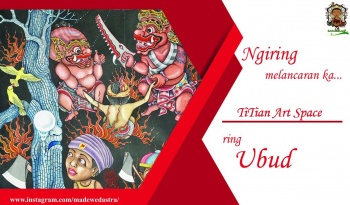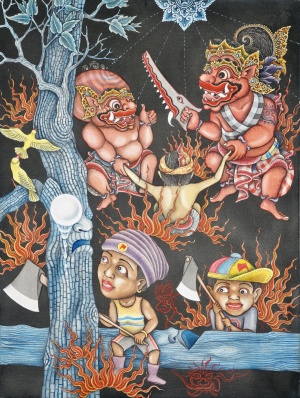Difference between revisions of "Place TiTian Art Space"
From BASAbaliWiki
Geoff Vivian (talk | contribs) |
|||
| Line 1: | Line 1: | ||
| + | {{PageSponsor}} | ||
{{Place | {{Place | ||
|Page Title=TiTian Art Space | |Page Title=TiTian Art Space | ||
| − | |Photograph= | + | |Photograph=Titian Art Space.jpg |
|Photograph reference link=http://www.titianartspace.com/ | |Photograph reference link=http://www.titianartspace.com/ | ||
|Information about place={{Place/Information | |Information about place={{Place/Information | ||
| Line 15: | Line 16: | ||
Typical Batuan paintings have myriad brightly-coloured figures on a black background, and leave the eye to wander from figure to figure with no clear centre of interest. Without departing from this formula, Sujendra has simplified and intensified the effect of the Batuan style by showing fewer figures on a much larger canvas and returning to religious themes. Two of the paintings in this show are black and white. | Typical Batuan paintings have myriad brightly-coloured figures on a black background, and leave the eye to wander from figure to figure with no clear centre of interest. Without departing from this formula, Sujendra has simplified and intensified the effect of the Batuan style by showing fewer figures on a much larger canvas and returning to religious themes. Two of the paintings in this show are black and white. | ||
You can see Sujendra’s paintings for a few more days if you are in Ubud, before the exhibition closes on January 20. Staff and members will then prepare to celebrate TiTian’s third anniversary on January 31. | You can see Sujendra’s paintings for a few more days if you are in Ubud, before the exhibition closes on January 20. Staff and members will then prepare to celebrate TiTian’s third anniversary on January 31. | ||
| + | |Photo of information=TiTian Art Space Ubud.jpg | ||
|Credit=Geoff Vivian | |Credit=Geoff Vivian | ||
}} | }} | ||
| + | |Linked words=Ubud, | ||
}} | }} | ||
Revision as of 12:09, 1 February 2019
- Name of Place
- TiTian Art Space
- Location
- Reference
- http://www.titianartspace.com/
- Lontar
- Folktales
- Biographies
- Children's Books
- Books
- Holidays and Ceremonies



Enable comment auto-refresher